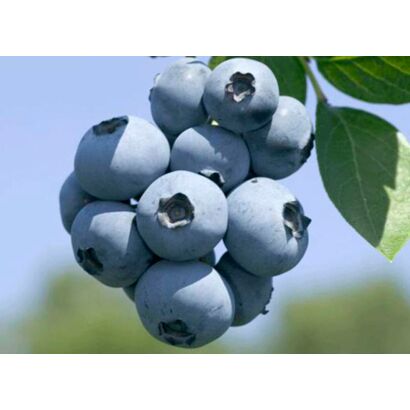Blueberry Polaris
Ripening period: average, July-August
Fruits: 1.2-1.5 gr., blue
Growing conditions: outdoors
Yield: 2-7 kg/plant
Selection: USA
| Shipping and pickup: | 2022 |
| Ripening period | Mid-season variety |
| fruit size | Large-fruited varieties |
| Productivity: | high |
| Selection | USA |
The Polaris blueberry was bred by breeders at the University of Minnesota in 1996 specifically for growing in the cold climate of the northern United States. Due to its increased frost resistance, the variety has become popular in Russia, especially in the Urals and Siberia.
Variety advantages:
- compact bushes;
- excellent taste;
- good yield;
- resistance to storage and transportation;
- frost resistance (up to –34°С).
Variety features
Plant. Polaris bushes are short, compact, upright, so they do not take up much space in the garden. Plant height up to 1.2 m, diameter 0.6-0.7 m. The leaves are dark green, elongated with sharp tips. They fall for the winter.
Fruits rounded, medium-sized, about 15 mm in diameter. The average weight of berries is 1.2-1.5 gr. The skin of ripe blueberries is blue with a bluish bloom, compacted. Pulp – jelly-like, sweet with a slight sourness and pronounced aroma.
Ripe berries do not crumble, do not burst during collection and storage. They tolerate transportation well. The variety is suitable for cultivation for sale.
The purpose of blueberries is universal. The fruits of Polaris are consumed fresh, they are used to prepare delicious desserts, jams, compotes, marmalade.
Yield and maturity. For the first 4-5 seasons, young blueberry bushes gain strength, during this period one plant produces about 2 kg of berries. The variety reaches its maximum yield by 6-7 years of growth, when up to 7 kg of berries can be harvested from an adult bush.
In terms of maturation, Polaris belongs to mid-season varieties. The harvest of ripe berries falls on 2-3 decades of July. Such a term – the advantage of blueberries, because the entire crop has time to ripen before the onset of cold weather.
Immunity. Polaris are rarely attacked by pests and practically do not get sick. Their appearance can be provoked by poor-quality care of plants and the garden as a whole, as well as incorrectly created conditions for growing blueberries.
Growing conditions. Blueberry Polaris tolerates frosts up to – 34 ° C, calmly winters under a layer of snow (without shelter) even in regions with a harsh climate. If winter is expected with little snow, the soil in the near-stem zone is mulched with a layer of straw to protect the root system from freezing. First-year seedlings are additionally covered with agrofiber.
In order for blueberries to develop well and bear fruit, they need light, acidic soil or a nutritious peat substrate with a pH of 3.5-5.0. Alkaline and neutral soils are contraindicated for culture. It is also important to ensure good drainage of the site. When moisture stagnates, the plant begins to hurt, and the – bitter and disappear.
Polaris needs to be cross-pollinated to produce a crop. Plant nearby 1-2 blueberry bushes that bloom at the same time.
Selection of seedlings
Before you buy Polaris blueberry seedlings, pay attention to the quality of the planting material.
- The age of suitable seedlings is 2-3 years,
- The root system – developed, moist, without breaks. Preferably closed type (with a clod of earth).
- The shoots are "alive", without dryness, damage and signs of disease.
Beware of fakes and contaminated planting material, buy blueberry seedlings «Polaris» in professional nurseries and specialized stores.
